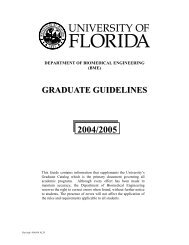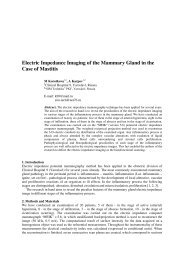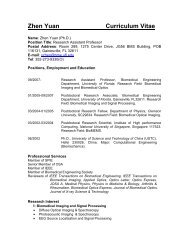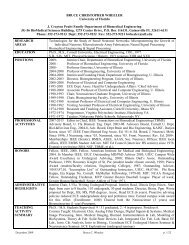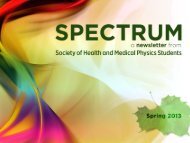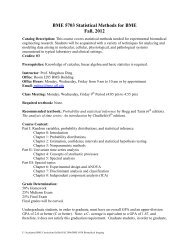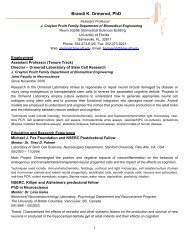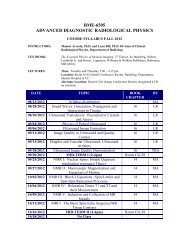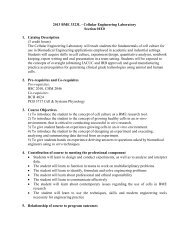Smirnov, A V; Nikolaev, D V; Kolesnikov, V A
Smirnov, A V; Nikolaev, D V; Kolesnikov, V A
Smirnov, A V; Nikolaev, D V; Kolesnikov, V A
You also want an ePaper? Increase the reach of your titles
YUMPU automatically turns print PDFs into web optimized ePapers that Google loves.
On measurement errors of the impedance spectrum of humanbody in vivoA V <strong>Smirnov</strong>, D V <strong>Nikolaev</strong>, V A <strong>Kolesnikov</strong>Scientific Research Centre ‘Medass’, Chistoprudny blvd, 12, 101000 Moscow, RussiaEmail: avs_ramb@rambler.ruAbstract. Deviations of the impedance spectrum of human body segments from that predictedby the Cole model are explained by the properties of biological objects and measurementerrors. Our analysis of the measurement’s equivalent scheme shows an importance of contactimpedances and allows for explaining positive reactance of low-resistance body segments.Representation of the measured impedance as a connection of the Cole model impedance andcapacity in parallel gives better fitting of measured impedance spectrum. The results ofanalysis show that said capacity is determined mainly by the properties of body tissues ratherthan stray capacitance between the body and surrounding objects.1. IntroductionThe frequency dependence of biological objects’ complex impedance is usually approximated by theCole model [1, 2]. This model is used for the description of biological tissues’ properties in in vitromeasurements [3]. However, in in vivo measurements, deviations of the impedance spectrum from thecircular arc predicted by the Cole model usually occur. Such deviations were explained previously byvarious factors, such as stray capacity between the body and surrounding objects, contact impedances,cable capacities, and other [4–6]. The aim of our study was to analyze quantitatively various factorsinfluencing the results of impedance measurements and discriminate between biological tissues’effects and that of measurement errors.2. Device and methodsBIA measurements were conducted by the analyzer ABC-01 ‘Medass’ (Moscow, Russia) thatmeasures complex impedance according to the conventional tetrapolar scheme using multiple (31)frequencies ranged from 5 to 500 kHz [7]. Two kinds of electrodes were used: the disposablebioadhesive electrodes with contact area 2.42.4 cm, and reusable AgCl electrodes with contact area2.53.6 cm, denoted as E1 and E2, respectively. E2 electrodes were used with the conductive gel.Patient’s cable was 1.8 m in length. The measurement was conducted in standing position distantlyenough from the conductive objects with legs and arms moved apart.The results of measurements were processed using device-supplemented software that allows forbest approximation of the impedance spectrum in an operating frequency range as the impedance Z Colecorresponding to the Cole model with the capacity C p taken in parallel. This capacity may beinfluenced by biological object’s own capacity, stray capacity, and measurement errors.
Figure 1. Equivalent scheme of themeasurement circuitBIA measurement errors were analyzed boththeoretically, i.e. using equivalent scheme calculations,and experimentally, i.e. by measuring the impedancesof reference circuits. Two kinds of errors wereconsidered: calibration errors as well as extra errorsdue to differences between the parameters ofequivalent scheme during measurement compared tothose during calibration procedure. Much attention waspaid to extra errors as calibration errors are systematicin nature and, hence, their influence can be minimized.Equivalent measurement circuit is shown on Fig. 1,where 1–4 – electrodes’ clamps, CG – currentgenerator, Z B – biological object impedance, C s – straycapacity, VM – voltmeter, Z C1 , Z C2 , Z C3 , Z C4 – contactimpedances, C 12 , C 13 , C 24 , C 34 – interelectrodeconsists of electrode’s own impedance, impedance ofcapacities. Each of impedances Z C1 –Z C4electrode to body contact, and impedance of body part between current and voltage electrodes.Capacities C 12 –C 34 are influenced by the device and cables capacities. It can be shown that theinfluence of the capacitance C s is equivalent to that of distributed stray capacitance between thesubject and surrounding objects.We simulated calibration and measurement procedures. For this, U m values were calculated usingequivalent circuit by the node potentials method. We utilized the same values of C 12 –C 34 on calibrationand measurements because of using the same cable. For contact impedances Z C1 –Z C4 , similarassumption is not reasonable because of dependence on the types of electrodes, their positioning, andthe properties of skin. The measurements using analyzer ABC-01 “Medass” includes registration ofthe impedances Z 13 and Z 24 between 1-3 and 2-4 clamps. These impedances give an approximation ofZ C1 and Z C2 impedances used in calculation of measured impedance. Such a correction was alsoimplemented during simulation of measurements. The data on interelectrode capacities and contactimpedances Z C3 and Z C4 were obtained from auxiliary experiments.Verification of the measurement model present in Fig. 1 was carried out by the comparison ofcalculated and experimentally derived error values. Then, using the obtained error values, possibledeviations of impedance spectrum under corresponding measurement conditions were analyzed.3. ResultsThe results of segmental BIA measurements of the impedance spectrum for healthy volunteer arepresented in Fig. 2. Similar spectrums were obtained for other volunteers. Fig. 3 shows estimates ofcontact impedances for electrode types E1 and E2.Fig. 4 shows the results of theoretical and experimental analysis of extra errors. Calculations ofexpected values of measurement errors of the resistance R and reactance X were performed for afrequency of 500 kHz in the range of R between 50 and 400 Ohms at X/R = 0,1. The following realvalues of interelectrode capacities were used: C 12 = 40 pF, C 34 = 60 pF, C 13 = C 24 = 70 pF. The valuesof impedances that simulated contacts at calibration were Z C1 = Z C2 = 100 Ohms, Z C3 = Z C4 == 10 Ohms. The values of contact impedances during measurement (based on Fig. 3b) were Z C1 = Z C2= 170 Ohms, Z C3 = Z C4 = 120 Ohms for E1 electrode type, and Z C1 = Z C2 = 70 Ohms, Z C3 = Z C4 = 40Ohms for E2 electrode type. Calculations with other parameters show that, in first approximation, themagnitude of errors is proportional to the frequency value and interelectrode capacities. Experimentalestimates of measurement errors, denoted as E1exp and E2exp, were obtained using reference circuitsthat simulated biological object and contacts of E1 and E2 electrodes. Calibration errors wereexcluded by measurement of reference circuits corresponding to calibration conditions.Results of approximation of the impedances of measured body segments using the impedance Z Coleand capacitance C p taken in parallel are given in Table 1.
Figure 2. Impedance plots of body segments: wrist-to-ankle (a), elbow-to-knee (b), knee-to-knee(c), proximal forearm (d)Figure 3. Z C1 and Z C2 impedance plots (a), frequency dependences of modules of Z C3 and Z C4 (b)Figure 4. Resistance (a) and reactance(b) measurement errors dependences on resistance valueTable 1. The results of BIA segmental measurementsBody segment SEE Cole,Cp,pFSEE Cp,R 500 ,X 500 ,ΔR 500 ,ΔX 500 ,ΔR 50 ,ΔX 50 ,Wrist-to-ankle 2,43 60 0,54 297 -27.5 2,2 16.7 0,6 2,2Wrist-to-wrist 1,03 40 0,51 327 -27.8 1,7 13.5 0,5 1,7Elbow-to-knee 1,59 180 0,71 135 -12.8 1,1 10.3 0,5 1,5Knee-to-knee 0,82 320 0,22 76 -7.4 0,7 5.8 0,3 0,8Results in the Table 1 were obtained using E2 electrode type. Here, SEE Cole and SEE with C p arestandard errors of the impedance approximation as Z Cole only and Z Cole with C p capacitance taken in
parallel; R500 and X500 are measured values of resistance and reactance at a frequency of 500 kHz;R500 and X500 are changes in resistance and reactance at a frequency of 500 kHz after eliminationof the capacitance C p influence on measured impedance; R50, X50 are similar changes at afrequency of 50 kHz.4. Discussion and conclusionsThe impedance plots shown in Fig. 2 for body segments of various resistances are similar to thosepublished by other authors [4, 5, 8]. The results of error analysis (Fig. 4) provide an opportunity toexplain the differences of impedance spectrum of different body segments. Satisfactory agreementbetween calculated and experimental error values suggests that such an explanation is correct.In case of body segments with the resistances over 200 Ohms an effect is prevalent of the low-passfilter of the impedances Z C3 , Z C4 and capacitance C 34 (Fig. 2a). In the resistance range 100–200 Ohms,change of polarity of the reactance measurement error takes place for the E1 electrodes caused by thepredominant effect of C 13 and C 24 capacitances that transmit voltage from the current generator outputdirectly to the voltage gauge. This leads to the shift of the high-frequency end of an impedance plot inpositive direction (Fig. 2b,c). In both ranges effects strongly depend on the contacts impedance. Othervalues of interelectrode capacities entail changes in the boundaries range.If absolute value of the impedance is less than 100 Ohms, then the positive error of the reactancemeasurement with electrodes E1 becomes so large that the measured value of the reactance X reversesits sign (Fig. 2d). The error of resistance R also reverses sign (Fig. 4a). The observed form of theimpedance locus is sometimes interpreted as the presence of an inductive component. But this effect isformed by joint action of the interelectrode capacities and contacts impedances. So, when measuredlow-resistant body segments, the electrodes contact impedance may produce unreliable results.For sufficiently large object resistances and small contact impedances the measurement providesreliable information on the object impedance. Table 1 show that the values of X500 are significantlyhigher than the absolute value of the expected error of the reactance when measured using E2electrodes (Fig. 4b). So, the capacitance C p is really present in measured impedance, and is not theresult of measurement errors. Representation of measured impedance as the parallel connection ofZ Cole and C p significantly improves an accuracy of approximation. Note also, that excluding of the C pcapacitance exerts little effect on the results of measurements at the frequency 50 kHz.Since the value of C p increases with the decrease of resistance of measured segment, one can drawconclusions about the nature of this capacity. Stray capacitance C s must increase with length and,hence, with the resistance of segment. Yet, the resistance and own capacity of a homogeneous objectare linked by obvious relation RC = , where is the resistivity, and the dielectric constant. Thus,the value of C p is determined primarily by the capacitive component of the biological objectimpedance Z B rather than by the stray capacitance C s .In conclusion, understanding the nature and properties of errors caused by contact impedances andinterelectrode capacitances gives a possibility to improve methods of calibration and measurements bythe correction of the influence of these elements.References[1] Cole K S 1932 J. Gen. Physiol. 15 641–649[2] Grimnes S, Martinsen O G 2000 Bioimpedance and Bioelectricity Basics (London: AcademicPress)[3] Gabriel S, Lau R W, Gabriel C 1996 Phys. Med. Biol. 41 2271–2293[4] De Lorenzo A, Andreoli A, Matthie J, Withers P 1997 J. Appl. Physiol. 82 1542–1558[5] Bolton M P, Ward L C, Khan A et al 1998 Physiol. Meas. 19 235–245[6] Grimnes S, Martinsen O G 2007 J. Phys. D:Appl. Phys. 40 9–14[7] <strong>Nikolaev</strong> D V, <strong>Smirnov</strong> A V, Bobrinskaya I G, Rudnev S G 2009 Bioelectric impedanceanalysis of human body composition (Moscow: Nauka)[8] Beckmann L, Cordes A, Saygili E et al 2009 IFMBE Proceedings 25/VII, 532–535



